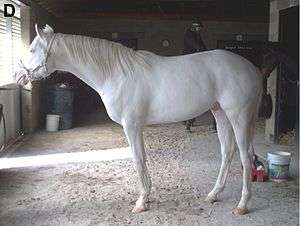Leucism



Leucism (/ˈljuːkɪzəm/;[1] or /ˈluːsɪzəm/[2][3]) is a condition in which there is partial loss of pigmentation in an animal resulting in white, pale, or patchy coloration of the skin, hair, feathers, scales or cuticle, but not the eyes.[1] Unlike albinism, it is caused by a reduction in multiple types of pigment, not just melanin.
Details
Leucism (occasionally spelled leukism) is a general term for the phenotype resulting from defects in pigment cell differentiation and/or migration from the neural crest to skin, hair, or feathers during development. This results in either the entire surface (if all pigment cells fail to develop) or patches of body surface (if only a subset are defective) having a lack of cells capable of making pigment.
Since all pigment cell-types differentiate from the same multipotent precursor cell-type, leucism can cause the reduction in all types of pigment. This is in contrast to albinism, for which leucism is often mistaken. Albinism results in the reduction of melanin production only, though the melanocyte (or melanophore) is still present. Thus in species that have other pigment cell-types, for example xanthophores, albinos are not entirely white, but instead display a pale yellow colour.
More common than a complete absence of pigment cells is localized or incomplete hypopigmentation, resulting in irregular patches of white on an animal that otherwise has normal colouring and patterning. This partial leucism is known as a "pied" or "piebald" effect; and the ratio of white to normal-coloured skin can vary considerably not only between generations, but between different offspring from the same parents, and even between members of the same litter. This is notable in horses, cows, cats, dogs, the urban crow[4] and the ball python[5] but is also found in many other species.
A further difference between albinism and leucism is in eye colour. Due to the lack of melanin production in both the retinal pigmented epithelium (RPE) and iris, those affected by albinism typically have red eyes due to the underlying blood vessels showing through. In contrast, most leucistic animals have normally coloured eyes. This is because the melanocytes of the RPE are not derived from the neural crest, instead an outpouching of the neural tube generates the optic cup which, in turn, forms the retina. As these cells are from an independent developmental origin, they are typically unaffected by the genetic cause of leucism.
Genes that, when mutated, can cause leucism include, c-kit,[6] mitf[7] and EDNRB.[8]
Etymology
The terms leucistic and leucism are derived from medical terminology (leuc- + -ism). The stem leuc- is the Latin variant of leuk- from the Greek leukos meaning "white" (see Stedman’s, Dorland’s or Taber’s medical dictionaries).
Gallery
| Wikimedia Commons has media related to Leucism. |
 Leucistic Texas rat snake (Elaphe obsoleta)
Leucistic Texas rat snake (Elaphe obsoleta) Leucistic common grackle (Quiscalus quiscula)
Leucistic common grackle (Quiscalus quiscula) Leucistic Indian peacock (Pavo cristatus)
Leucistic Indian peacock (Pavo cristatus) Leucistic axolotls (Ambystoma mexicanum)
Leucistic axolotls (Ambystoma mexicanum) Leucistic red-tailed hawk (Buteo jamaicensis)
Leucistic red-tailed hawk (Buteo jamaicensis)
 Leucistic long-finned oscar (Astronotus ocellatus)
Leucistic long-finned oscar (Astronotus ocellatus)- Leucistic American rhea, (Rhea americana)
 Leucistic Reed Bunting (Emberiza schoeniclus)
Leucistic Reed Bunting (Emberiza schoeniclus) A Leucistic Mute swan cygnet (Cygnus olor) compared to a non-leucistic cygnet.
A Leucistic Mute swan cygnet (Cygnus olor) compared to a non-leucistic cygnet.
See also
- Albino and white squirrels
- Amelanism
- Dyschromia
- Erythrism
- Heterochromia iridum
- Melanism
- Piebaldism
- Vitiligo
- Xanthochromism
References
- 1 2 "leucism". The American Heritage Dictionary of the English Language (5th ed.). Boston: Houghton Mifflin Harcourt. 2014. Retrieved 8 December 2016.
- ↑ "leucistic". Oxford Dictionaries. Oxford University Press. Retrieved January 9, 2016.
- ↑ Merriam-Webster, Merriam-Webster's Unabridged Dictionary, Merriam-Webster, (subscription required (help)).
- ↑ White crows at Cornell University.
- ↑ Piebald ball pythons at Constrictors.com (archived 9 October 2006, from the original, accessed 18–22 July 2006).
- ↑ Coat colour, dominant white at Online Mendelian Inheritance in Animals.
- ↑ An L1 element intronic insertion in the black-eyed white (Mitf[mi-bw]) gene: the loss of a single Mitf isoform responsible for the pigmentary defect and inner ear deafness at Human Mulecular Genetics.
- ↑ Waardenburg syndrome at Atlas of Genetics and Cytogenetics in Oncology and Haematology (archived 26 December 2005, from the original, accessed 18–22 July 2006).
